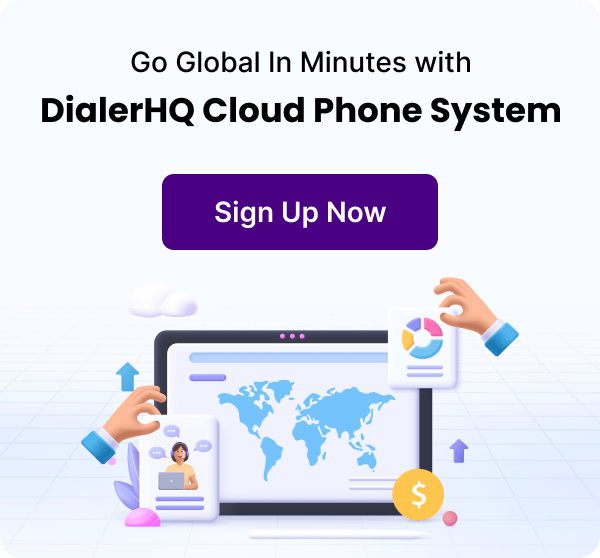Senior Writer: Paras Kela
Did you know that automation is expected to manage over 10% of agent interactions by 2026?
Call center automation has emerged as a transformative solution for businesses seeking to enhance their customer service operations, improve efficiency, and deliver seamless customer experiences.
Explore our in-depth guide on call center automation technology to learn the specifics of this idea and the strategies for integrating it into your call centers.
What is Call Center Automation?
Call center automation is the use of technological systems to carry out regular, time-consuming tasks without human involvement. This automated call center strategy has improved key call center performance indicators, including response times and first-call resolution rates.
Effective use of call center automation services revolutionizes processes and improves customer interactions.

Call Center Automation Results In:
- 30% decrease in average handling time
- 35% decrease in customer call volume and
- 10X boost in performance
Contact center automation tools make use of AI and machine learning to enable teams to effectively prioritize vital tasks by continuously adapting to changing demands.
Automating your call center automation process can enable you to improve your communication process. As a call center company, it’s of utmost importance to adopt a scalable, customizable solution that provides great results.
How Does Call Center Automation Work?
Call center automation utilizes various technologies and software to automate and streamline different processes within a call center. The process begins with identifying the tasks that can be automated, such as call routing, data entry, and information retrieval.
These tasks are then assigned to automated systems like interactive voice response (IVR) or chatbots. IVR systems use pre-recorded voice prompts and menu options to guide callers through self-service options or direct them to the appropriate department or agent.
On the other hand, chatbots use natural language processing (NLP) algorithms to understand customer inquiries, provide instant responses, or escalate the conversation to a human agent if necessary.
What Are the Steps to Implement Call Center Automation?
Implementing call center automation involves careful planning and execution to ensure a smooth transition and successful integration of automation technologies. Here are the steps to follow when implementing call center automation:
Step 1: Define objectives and identify pain points
Step 2: Conduct a comprehensive needs assessment
Step 3: Research and select suitable automation solutions
Step 4: Develop an implementation plan
Step 5: Customize and configure automation tools
Step 6: Provide training and skill development
Step 7: Pilot testing and fine-tuning
Step 8: Monitor and measure performance
Step 9: Continuous improvement and adaptation
Step 10: Provide ongoing support
What Are the Different Types of Call Center Automation?
Choosing the right type of call center automation software for your call center requires consideration. The following are a few popular categories of automation that are frequently employed in call center environments. Let’s take a look.

1. Predictive Dialing
A predictive dialing system is an automated outbound calling solution that doesn’t require human intervention initially. When a call is answered, an available agent is contacted. Advanced algorithms like machine learning and statistical approaches use methods like regression analysis, probability theory, and queuing theory to forecast call outcomes.
Predictive dialing reduces idle time between engagements, maximizing agent efficiency by effectively linking outbound calls to agents when they’re ready. The system can also be applied to complex tasks like making cold calls to potential customers and conducting market research surveys.
2. Interactive Voice Response (IVR)
Interactive Voice Response (IVR) technology enables user engagement with computer-operated telephone systems using voice instructions and Dual-Tone Multi-Frequency (DTMF) tones typed through a keypad. These systems handle several calls at once, connecting callers to appropriate departments or agents.
IVR systems allow for the provision of customized services based on client profiles. Caller options include automated services, queue waiting, and callback requests. IVR technology aims to augment the call center experience by efficiently handling simple customer inquiries reducing agents’ workload.
3. Data Entry And Processing
Data entry is the process of inputting or transferring data into a computer system or database. Integrating contact centers improves data accuracy by removing the need for agents to enter data twice and streamlining data extraction for reporting. With data entry and processing, physical documents can be digitalized more easily because the extracted data can be easily transferred to an ERP or database.

The automated data entry software permits the effective extension of data input activities without resulting in extra overhead expenses. Ultimately, there are significant long-term cost benefits as a result of the combination of faster turnaround times, lower mistake rates, and scalable capabilities.
4. Chatbots
Chatbots, also known as chatterbots, efficiently carry out routine tasks. They serve as adept assistants in handling simple tasks like addressing frequently asked questions or offering basic customer support. Chatbots are computer programs that simulate human communication. They differ in the artificial intelligence features they offer.
However, more recent versions incorporate conversational AI techniques, such as natural language processing, to understand user questions and generate automated answers. By simulating human conversation through automated interactions, these products provide clients with additional convenience at little or no cost.
5. Workforce Management Automation
Workforce management automation is a complex staffing plan that uses a systematic approach to guarantee that the right number of agents with the necessary abilities are hired at the right times. Automated workforce management solutions make it easier to schedule agents’ shifts, track their performance, and adjust staffing numbers, ensuring prompt contact response and reducing wait times.
Automated workforce management helps businesses retain efficiency and accuracy in labor forecasting by utilizing historical data for future scheduling. It is further strengthened when combined with additional solutions like IVR software.
What are the Benefits of Call Center Automation?
Contact center automation uses technology and software to streamline and optimize the operations of a call center. Call centers can enhance efficiency, improve customer experience, and achieve cost savings by automating various tasks and processes.
Below are some of the key advantages of implementing call center automation.

1. Increased Efficiency
Automation eliminates repetitive tasks and streamlines processes, allowing call center agents to focus on more complex and value-added activities. This leads to improved productivity and shorter call handling times, resulting in faster issue resolution and reduced customer wait times.
2. Cost Reduction
Businesses can reduce staffing requirements by automating routine tasks, leading to cost savings. Additionally, automation helps minimize human errors, reducing the need for rework or customer callbacks. The use of self-service options and chatbots also enables handling a larger volume of inquiries without additional agents.
3. Improved Customer Satisfaction
When it comes to providing excellent online customer service, multiple consumers believe that time efficiency is crucial. A survey reported that for 51% of respondents, the fastest customer service resolution was via phone.

But, a lot of phone-based consumer interactions begin with the dreaded hold music. Automation overcomes this obstacle by initiating conversations with screening questions easily, authenticating clients quickly, and even answering customer queries through virtual agents. Requirements like statement requests and password retrieval are handled quickly by combining optimized backend processes with natural language processing.
4. 24/7 Availability
Automated systems can operate round the clock, allowing businesses to provide support and service outside traditional working hours. This ensures that customers can access assistance and information anytime, leading to improved customer loyalty and satisfaction.
5. Enhanced Data Management
Call center automation enables the integrating and synchronizing of various systems and databases, such as CRM software. This results in centralized and real-time access to customer data, allowing agents to comprehensively understand customer history and preferences.
Improved data management leads to more personalized interactions, better issue resolution, and targeted marketing efforts.
How to Calculate the ROI of Call Center Automation?
A simple and widely applicable formula is used to evaluate the return on investment (ROI) of a contact center:
ROI= [(Net gain from investment – money spent) / money spent] x 100
Let’s use a specific example to clarify this:
Increase in Revenue: A $15,000 increase following the installation of a new customer support system.
Expenses: $10,000 will be spent on the purchase and installation of the platform mentioned above.
Applying for these numbers now:
ROI = ($15,000 – $10,000) / $10,000 x 100
ROI = 50%
In this case, investing in the new platform delivers a 50% return on investment for the contact center. In a nutshell, the organization gains $1.50 for every dollar spent, which is a substantial return.
Measuring the immediate benefits of customer service software can be complex. The key is understanding the total investment outlay. Let’s examine this.
Let’s divide the costs into two main categories, Capital Expenditure (CapEx) and Operational Expenditure (OpEx), to gain a thorough understanding of contact center costs and efficiently calculate ROI.
| Category | Specific Investments | CapEx or OpEx |
|---|---|---|
| Technology and Software | Contact center software, CRM systems, automation tools | CapEx |
| Hardware Expenses | Servers, computers, telephony equipment, physical infrastructure, implementation, maintenance, and upgrades | CapEx |
| Training and Development | Training programs for agents, supervisors, staff development | OpEx |
| Operational Costs | Utilities, rent, maintenance, day-to-day operational expenses | OpEx |
| Telecommunication Costs | Phone lines, internet connectivity, communication infrastructure | OpEx |
There are additionally associated expenses that are either OpEx or CapEx based on the type of expense and the accounting practices of your company.
What Are the Major Challenges of Call Center Automation?
While call center automation offers numerous benefits, it also poses certain challenges that organizations must address to ensure a successful implementation. Below are the main challenges faced by call center agencies –

1. Technology Integration and Complexity
One of the significant challenges in call center automation is integrating various call center automation technologies and systems seamlessly. Call centers often rely on multiple software applications, databases, and communication channels, which must be integrated with the automated system.
Ensuring compatibility and smooth data exchange between these components can be complex, requiring extensive planning, customization, and technical expertise.
2. Data Accuracy and Quality
Automation heavily relies on data to provide accurate and relevant information to customers. However, maintaining data accuracy and quality can be challenging, especially when dealing with large volumes of customer information.
Inaccurate or outdated data can lead to incorrect responses, poor customer experience, and decreased efficiency. Regular data cleansing, validation processes, and quality control measures are essential to overcome this challenge.
3. Customer Resistance to Automation
Some customers may be hesitant or resistant to interacting with automated systems. They might prefer human interactions, especially for complex or sensitive issues. Organizations must address this challenge by offering a seamless transition between automated and human-assisted support.

Implementing effective strategies to educate customers about the benefits of automation and ensuring a smooth handoff to human agents when needed can help overcome this resistance.
4. Customization and Personalization
While automation offers efficiency and scalability, striking the right balance between automation and personalization can be challenging. Customers expect personalized experiences, and generic or scripted responses from automated systems may not meet their expectations.
Implementing intelligent automation that can adapt to individual customer preferences, past interactions, and unique requirements can help overcome this challenge.
What Are the Top Future Call Center Automation Trends?
Automation is rapidly growing in contact centers. While providing excellent customer experiences may not always be automated, having appropriate technology can have a big impact on a company’s success.
Here are a few automation developments that will likely influence the market in the upcoming years and beyond.
1. Robotic Process Automation (RPA)
With robotic process automation, multiple operational processes and rule-driven tasks, like call routing, customer identification, data input, system upgrades, appointment scheduling, and more, have been simplified in call centers.

As AI technologies continue to advance and improve, RPA in contact centers is expected to continue its current trajectory, resulting in greater operational effectiveness and increased agent productivity.
2. Smart Interactive Voice Response (IVR)
In the next few years, Interactive Voice Response (IVR) systems will evolve with advanced and user-friendly interfaces.
With the integration of extensive AI algorithms and natural language processing powers, automated voice response (AVR) systems are increasingly able to understand and provide rapid answers to client phone calls.
These complex IVR systems are excellent at assisting users with complex processes, safely confirming the identity of callers, and providing recommendations that are specifically catered to the interests and histories of each user.
3. Generative Artificial Intelligence
With the introduction of advanced virtual agents, advanced generative AI has the potential to completely transform contact centers. These agents, in contrast to their predecessors, show a proactive approach, going beyond mere reactiveness. They are excellent at tailoring their reactions to the specifics of each engagement and are skilled at emulating the formal, serious, or lighthearted tones of each client.

Contact centers can implement contextual bots with remarkably human-like behavior by utilizing generative AI, which will enable seamless end-to-end client self-service. This invention greatly improves resolution rates while simultaneously cutting average hold times.
These intelligent chatbots are capable of accurately interpreting the intentions of their users and customizing their responses to ensure optimum efficacy and relevancy.
4. Conversational Speech Analytics and Sentiment Analysis
Advanced technologies like Natural Language Processing (NLP), Natural Language Understanding (NLU), and Machine Learning (ML) algorithms are used by advanced real-time conversational analytics solutions to examine client interactions in real time. In doing so, they provide managers and agents with significant insights about behavior, intent, and subtle emotional aspects of client involvement.
These realizations prove crucial in improving the dynamics of interactions in contact centers. They allow businesses to improve call quality, guarantee regulatory compliance, track and improve agent performance, and identify opportunities for agent growth.
Modern speech analytics and speech recognition software have sentiment analysis features that allow for the identification of emotional undertones in speech. This ability enables contact center agents to skillfully adapt their responses, reacting delicately to changes in feeling, whether favorable or unfavorable.
5. Hyper-Personalized Experiences
Contact center hyper-personalization focuses on the precise construction of customized experiences via the application of advanced sentiment analysis, unified customer profiles, and customer interaction analytics.
Sentiment analysis enables advanced talks by identifying and understanding emotional clues. With an AI-driven approach to customer service, every contact center interaction is driven by a deep understanding of the consumer, which naturally produces a tailored experience.
Conclusion
Call center automation offers significant advantages in streamlining operations, improving efficiency, and enhancing customer satisfaction. It is essential to strike the right balance between automation and human interaction, ensuring that personalized and empathetic customer support is not compromised.
To fully benefit from call center automation, organizations should carefully assess their specific needs, choose the right automation tools, and continuously monitor and adapt their automation strategies to meet evolving customer expectations. Businesses can deliver exceptional customer experiences while optimizing their call center operations for long-term success.
One example of an automated call center is Amazon's customer service system, known as "Amazon Connect." It utilizes advanced automation technologies such as chatbots and interactive voice response (IVR) systems to handle customer interactions efficiently. These automated systems can handle routine inquiries, provide information, and perform self-service tasks, offering customers faster and more convenient service. Yes, customer service can be automated to a certain extent. Automation technologies, such as chatbots, virtual agents, and AI-powered systems, have made significant advancements in recent years, enabling businesses to automate various aspects of customer service. Some of the current call center automation trends include the adoption of artificial intelligence (AI) for advanced virtual agents and chatbots, the use of data analytics for personalized customer experiences, the integration of automation with other channels like social media and messaging apps, and the focus on proactive customer service through proactive outbound messaging and notifications. Additionally, there is a growing emphasis on integrating automation with human agents for a seamless and personalized customer experience. With DialerHQ's Armenia Phone Numbers, you can do much more than just make calls. Our system is equipped with a variety of advanced communication and collaboration features, such as: Step 1: Add a customer service portal. Step 2: Use automation technology. Step 3: Define resolved. Step 4: Follow up with customers. Step 5: Focus on staff. Step 6: Use analytics. FCR is calculated by taking the total number of customer service cases successfully resolved on the first try and dividing it by the total number of cases handled on one specific day. It is then multiplied by 100 to get the percentage.FAQs

Paras Kela is an accomplished IT professional with 7+ years of industry experience, including 4+ years as a dedicated content writer. His expertise lies in crafting informative blogs on VoIP and cloud telephony, among other technical subjects. Outside his professional pursuits, he cherishes quality time with loved ones, indulges in watching documentaries, and finds solace in gardening.
Updated : April 23, 2024

Subscribe to our newsletter & never miss our latest news and promotions.





